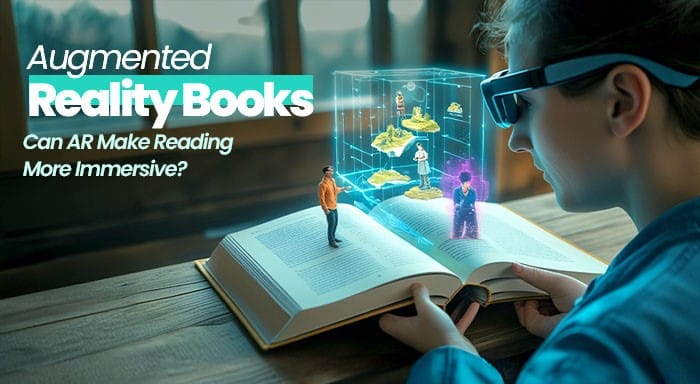A New Chapter in Storytelling
Books have always had the power to transport minds beyond the present. Now augmented reality is adding something new to that timeless magic. Instead of turning the page and picturing a scene, readers can see characters walk across the table or hear them speak as they step out of the story. It's not about replacing imagination but nudging it with extra colour and motion.
This mix of paper and pixels is not entirely science fiction. AR books for children already let dinosaurs roar from printed pages. More experimental fiction is blending printed words with digital overlays that change depending on where the book is read. With this transformation, reading has become more engaging and feels like a realistic experience. Instead of watching a scene unfold in the mind's eye it plays out in full view.
Where Books Meet Technology
The mechanics behind augmented reading are surprisingly simple. A phone or tablet camera scans a printed marker or pattern on the page. Then an app brings the scene to life. What used to be flat text becomes a three-dimensional space that readers can explore from different angles. For younger audiences this technology turns reading into play. For older readers it opens new forms of narrative that blend words with movement.
Publishers are now exploring how to balance content with interaction. Some experiments feel like walking through a museum with a headset, while others aim to preserve the quiet flow of turning pages. The challenge is clear—enhance the story without drowning it in spectacle. That shift opens the door for new opportunities for storytelling where books do not just speak—they perform.
To understand what makes this blend of reading and AR so compelling, consider these emerging features:
Visual Anchors That Shift With Storylines
AR allows for scenes to unfold differently based on reader movement or decision. A story set in a haunted house might reveal a ghost only if the reader views a certain corner of the room through their screen. These dynamic visuals adjust based on context creating a richer layer of suspense or wonder.
Audio Cues That Build Emotion
Instead of silent reading AR books can use ambient sound to heighten the atmosphere. A thunderclap in a gothic novel or street chatter in a modern drama can add subtle tension. These sounds are often tied to key plot moments reinforcing emotion in ways plain text cannot match.
Character Interaction in Real Space
Some AR experiences allow readers to place characters into their own environment. A detective might pace the living room while monologuing clues. A dragon might land on a kitchen table mid-flight. These interactive elements blur the line between fiction and physical space turning imagination into visible motion.
These elements are more than decoration. They shift the reading experience from private to participatory. After the list ends readers often return to the written page with a deeper sense of connection to the story. That interplay between old and new makes AR books feel like a bridge between print and performance.
The Reading Habit Reimagined
This new approach to books might sound futuristic but it touches something ancient—the desire to see stories come alive. Just as early humans painted animals on cave walls AR brings tales into shared space again. It might feel like play yet its potential for education is just as strong.
For students struggling to stay focused long texts often feel distant. With AR those same texts can light up with diagrams movement and even guided narration. The material becomes easier to remember because it is experienced not just read. While this doesn’t mean every textbook needs dancing atoms it opens the door to thoughtful enrichment that supports memory and understanding.
Public libraries and learning platforms are starting to catch on. Readers don’t see Augmented Reality as a novelty anymore—it's a way to connect with the stories more deeply. And thanks to open-access e-libraries, the spread of interactive content grows faster each year. From academic works to fiction, Z-library just like Library Genesis or Project Gutenberg, provides unlimited reach to materials that once stayed locked behind paywalls. Now those same works can evolve with technology and reach broader minds.
Fiction That Walks Off the Page
Writers who once relied only on prose now think like stage directors. They imagine not just what is said but also how it looks and sounds in a room. This creative revolution quietly transforms fiction. Books can now react to readers in real time. A chase scene might speed up if the reader moves quickly or slow down when the room grows quiet.
Not every genre benefits equally. Poetry often prefers stillness while thrillers embrace momentum. However, AR unlocks new opportunities for all kinds of stories. A memoir could show family photos when a page is scanned. A science book could display a planet that spins in hand. These layers bring fresh meaning and offer ways to revisit stories through a different lens.
At its core, the reading doesn’t change—it’s still around the convergence between mind and meaning. But when a character steps from a page and greets the reader with a gesture the bond deepens. That might not replace the beauty of quiet reading, but it adds another flavour to the feast. And just like a good book, AR leaves a robust impression that sticks with you, even after you have put down your device.



